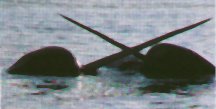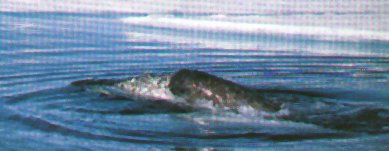
Narwhal

Order: Cetacea Family: Monodontidae Genus & Species: Monodon monoceros
Occurs at latitudes beyond 60o North, around the Arctic Ocean and the connecting seas off eastern Canada, Greenland and western Russia. They are a large relative of the dolphins, remarkable for the unicorn tusk sported by the male. They are listed as threatened by the World Conservation Union due to centuries of hunting.
| Habitat The narwhal ranges around the rim of the Arctic Circle, within 1000km of the North Pole. It lives mainly at latitudes of 70o - 80o North in near freezing conditions, and can survive in waters where the surface is littered with icebergs or covered with a flotsam of loose pack ice. |
 |
| But when winter sends thick sheets of ice over much of the Arctic, the
narwhal must migrate south to escape being locked below the surface. The western
population heads to the Davis Strait and Hudson Bay off North America, while the eastern
population migrates to the Barents Sea, the Greenland Sea or the Denmark Strait. As the ice retreats in spring, the narwhal returns north. Some individuals keep to the open seas, while others enter the fiords of northern Baffin Island and the Greenland Coast. They breed in these deep and sheltered waters, often remaining there until the ice starts to form in October. |
 |
Behaviour The narwhal usually lives in single-sex pods of 3 to 20 individuals, although larger pods may gather in rich feeding grounds. Individuals communicate in whistles, screeches and clicks, for example, to warn others of an approach of a killer whale. |
| There are many wild theories on the purpose of the male's tusk, but its
primary purpose probably lies in asserting sexual dominance, rather like the horns and
antlers of many hoofed mammals. The male brandishes his tusk during encounters with
rivals, and uses it as a duelling weapon if ritual display fails to settle rivalries.
Many males have been found with broken tusks and deep scars on the head. |
Feeding The narwhal mainly eats squid and shrimps, although it also feeds on the abundant Greenland halibut, polar cod and Arctic cod. Often feeding at the seabed, the narwhal can dive for 15 minutes to depths of 370m. |
 |
| Nearer the surface it feeds on juvenile and larval squid, and on shoaling
Arctic cod. With the exception of the male's tusk, the narwhal is effectively toothless
and swallows its prey whole. The male's tusk is always worn smooth, which suggests that he may use it to winkle food items from the seabed. The narwhal also emits clicks, not unlike those used by cetaceans that hunt using echolocation. The narwhal, too, may possibly use clicks to build up a 'sound image' of its prey. This method would certainly serve its purpose in the Arctic, where the long winter nights plunge the water into darkness for much of the year. |
 |
Breeding The narwhal mates in the spring, on its return north after the winter freeze. After a 15 month gestation period the female enters a deep sheltered bay within a fiord to give birth. |
| The brownish grey newborn weighs around 80kg. It suckles every hour, fattening quickly on its mothers rich milk, and rarely leaves her side. It is not fully weaned until two years old, by which time it has developed the characteristic white belly and its mother may once again be pregnant. |